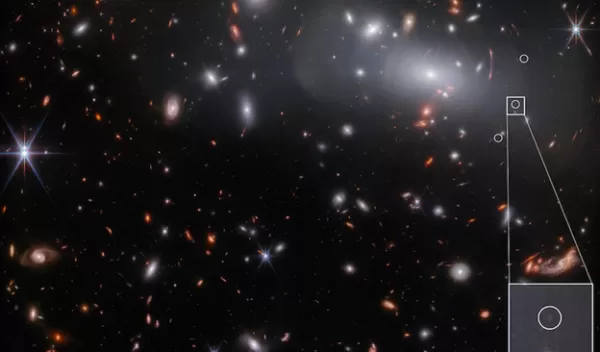
Astronomers find a remarkably small and distant galaxy
Supported by the U.S. National Science Foundation and using first-of-their-kind observations from the James Webb Space Telescope, a University of Minnesota Twin Cities-led team looked more than 13 billion years into the past. There the researchers discovered a unique, minuscule galaxy that generated new stars at an extremely high rate for its size.
The galaxy is one of the smallest ever found at this distance and could help astronomers learn more about galaxies that existed shortly after the universe came into existence. The researchers made use of a phenomenon called gravitational lensing, in which the light from a distant galaxy is deflected as it passes by a strong gravitational field.
The process can generate multiple images of a distant galaxy while simultaneously increasing its brightness and, in effect, enhances a telescope's ability to detect exceedingly faint objects. In this discovery, gravitational lensing allowed the James Webb to see the distant galaxy—which otherwise would have been too faint. The results are published in Science.
“This galaxy is far beyond the reach of all telescopes except the JamesWebb, and these first-of-their-kind observations are spectacular,” said Patrick Kelly, senior author of the paper. “We’re able to see most of the way back to the Big Bang. We've never looked at galaxies when the universe was this young in this level of detail. The galaxy’s volume is roughly a millionth of the Milky Way’s, but we can see that it’s still forming the same number of stars each year.”
The James Webb telescope can observe a wide enough field to image an entire galaxy cluster at once. The researchers were able to find and study this new, tiny galaxy because of a phenomenon called gravitational lensing; mass, such as that in a galaxy or galaxy cluster, bends and magnifies light. A galaxy cluster lens caused this small background galaxy to appear 20 times brighter than it would if the cluster were not magnifying its light.
The researchers then used spectroscopy to measure how far away the galaxy was, in addition to some of its physical and chemical properties. Studying galaxies that were present when the universe was much younger can help scientists understand the transition from an opaque sea of fundamental particles, the so-called "dark ages" of the universe, to the emergence of the first stars and galaxies.
